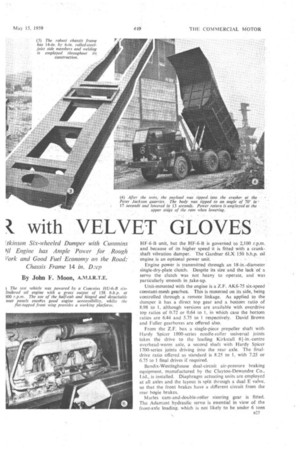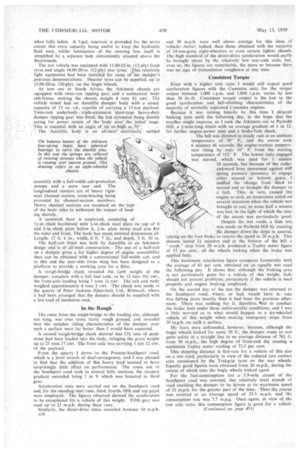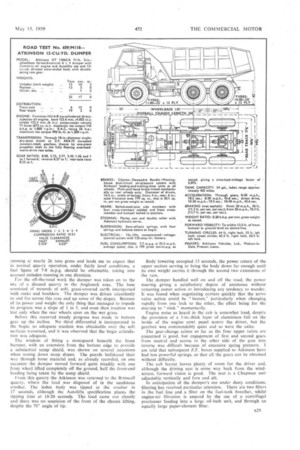BRU,
Page 58

Page 59

Page 60

Page 63

If you've noticed an error in this article please click here to report it so we can fix it.
with VELVET.. GLoyEs:-. ltkinson Six-wheeled Dumper with Cummins il Enginehas Ample 'Power for . Rough vork and Good Fuel 'Economy on the Road: Chassis Frame 14 in. D2ep By John F. Moon, A.M.L.R.T.E. THE near-side front wheel was lifted completely clear of the ground on one occasion when testing the Atkinson six-wheeled dumper across the floor of a disused quarry, but this did not impede its Tank-like progress across the soft, rough material. This is the kind of performance demanded of a dumper, but not always obtained, and it speaks well for • the cross-country capabilities of the Atkinson design, which was running at nearly 26 tons gross weight.
Similar to 47 dumpers supplied last year to the South African Railways, who are employing them on the construction of a new railway line between Johannesburg and Durban, the vehicle was shown on test to have as commendable a performance on the road as off it. Its British-built Cummins oil engine provided ample power, with the added advantage of goad fuel economy, whilst the braking system was able to halt the vehicle on a streaming wet road from 30 m.p.h. in 76 ft. 6 in.
The machine offered for test was displayed on the Atkinson stand at last year's Commercial Motor Show, since when it has been engaged on an arduous series of quarry demonstrations. It had come straight from such a demonstration when 1 took it over, preparation for my test being confined to adjustment of the brakes and the installation of a fuel test tank.
n/4 • The side members of the robust welded frame are 14-in. by 6-in, rolled-steel joists, tapered down slightly at the front to lower the cab floor. They are braced by three I-section cross-members in the vicinity of the rear bogie, additional bracing being provided by the welded cradle for the tipping rams and by the rearmost cross-member, which is gusseted to the side members to form a towing bracket. The foremost cross-member and the deep-Section. bumper bar are bolted in position to facilitate forward removal of the engine. The spring-hanger and balance-beam-pivot brackets also have fitted bolts. .
A . four-spring rear suspension layout is employed, whereas twin inverted semi-elliptic springs are more often found on dumpers. By a patented Atkinson system the spring ends are ball-jointed to relieve the springs of torsional stresses when the axles are articulating. A bogie with twin-spring suspension is available if demanded. This design allows, diagonal articulation of 5 in. without spring deflection, which should be more than adequate for normal operation in hard-surfaced quarries.
A gross power output of 158 b.h.p. (145 b.h.p. net) is yielded by the Cummins HU-6-B 11-litre six-cylindered oil engine at the governed speed of 1,800 r.p.m. The peak 4orque output of490 lb.-ft. occurs at 1,200 r.p.m, The engine is •generally similar to the more powerful Cummins
HF-6-B unit, but the HF-6-B is governed to. 2,100 r.p,m. and because of its higher speed it is fitted with a crankshaft vibration 'damper. The G.ardner 6LX 150 b.b.p. oil engine is an optional power unit. . , •
Engine power is transmitted through an 18-in.-diameter single-dry-plate Clutch: Despite-its size and the lack 'of a servo the clutch was not heavy to operate, and was particularly smooth in ,take-up.
Unit-mounted with the engine is a Z.F. AK6-75 six-speed constant-mesh gearbox. This is mounted on its side, being controlled through a remote linkage. As applied to the dumper it has a direct top gear and a bottom ratio of 8.98 to 1, although versions are available with overdrive top ratios of 0:72 or 0.64 to 1, in which case the bottom ratios are 6.44 and 5.75 to 1 respectively. David Brown and Fuller gearboxes are offered also.
From the Z.F. box a single-piece propeller shaft with Hardy Spicer 1800-series needle-roller universal joints takes the drive to the leading Kirkstall 81-in.-centre overhead-worm axle, a second shaft with Hardy Spicer 1700-series joints driving into the rear axle. The finaldrive ratio offered as standard is 8.25 to 1, with 7.25 or 6.75 to 1 final drives if required.
Bendix-Westinghouse dual-circuit air-pressure braking equipment, manufactured by the Clayton-Dewandre Co., Ltd., is installed. Diaphragm actuating units are employed at all axles and the layout is split through a dual E valve, so that the front brakes have a different circuit from the rear bogie brakes.
Manes cam-and-double-roller steering gear is fitted. The Adamant hydraulic servo is essential in view of the front-axle loading, which is not likely to be under 6 tons 1315
when fully laden. A 5-gal. reservoir is provided for the servo circuit this extra capacity being useful to keep the hydraulic. fluid cool, whilst lubrication of the steering box itself is simplified by a separate tank conveniently situated above the floorboards.
The test vehicle was equipped with 11.00-22-in. (12-ply) front tyres and single 14.00-20-in. 112-ply) rear tyres. This relatively light equipment had been installed for some of the dumper's previous demonstrations. Heavier tyres can be supplied, up to 15.00-20-in. (20-ply), on the bogie wheels.
As sent out to South Africa, the Atkinson chassis are equipped with twin-ram tipping gear and a 'substantial body sub-frame, making the chassis . weight 8 tons 81 cwt. The vehicle tested had an Autolifts dumper body with a struck capacity of 12 cu. yd., capable of carrying a 15-ton payload. Twin-ram underbody triple-extension slant-type heavy-duty dumper tipping gear was fitted, the 134 extension „being double acting for power return of the -body over the initial' stage. this is essential. with an angle of -tip as high as ,70°.
The Autolifts bodyis an all-steelelectrically welded
assembly with a full-width cab-protection canopy and a scow. rear end. The longitudinal runners are of heavy rigidsteel channel section, cross-bracing being provided by channel-section members. Heavy channel "sections are mounted on the tops of the body sides to withstand the impact of loading shovels.
A' sandwich floor is employed, consisting of 1+-in-thick-hardwood with -1-in.-thick steel plate on top of it and -1-in.-thick plate 'below it, 1-in. plate being used also for the sides and front. The body has mean internal dimensions of: Length, 12 ft. 6 in.; width, 6 ft, 7 in., and -depth, 3 ft. 10 in.
The half-cab fitted was built by Autolifts to an Atkinson design and is of .all-steel construction. The use of a half-cab On a dumper gives a far higher degree of engine accessibility than can. be obtained with a conventional full-width cab, and to this end the near-side front wing has been designed as a platform to provide a working area for a fitter.
A weigh-bridge check revealed the kerb weight of the dumper, complete with a full fuel tank, to be 12 tons 10icwt., the front-axle loading being 5 tons 11 cwt. The cab and body weighed approximately.4 tons 2 ewt.. The check was made at the quarry of .Peter Jackson (Quarries), Ltd., Brinscall, where it had been-arranged that the dumper should be supplied with a test load of sandstone rock.
In the Rough The route from the weigh-bridge to the loading site, although not long,was over some fairly rough ground, and revealed that the unladen riding characteristics of the dumper over such a surface were far better than I would have expected.
A. second weigh-bridge check showed that 131 tons of sandstone had been loaded into the body, bringing the gross weight up to 25 tons 17 cwt. The front axle was carrying 1 ton 12 cwt. of the payload.
From the quarry I drove to the Preston-Southport road, which is a level stretch of dual-carriageway, and I was pleased to find that the addition of this heavy load seemed to have surprisingly little effect on performance. The route out to the Southport road took in several hilly sections, the steepest gradient ascended being 1 in 9, which was breasted in third gear.
Acceleration tests were carried out on the Southport road and, for the standing-start runs, third, fourth, fifth and top gears were employed. The .figures obtained showed the acceleration to be exceptional for a vehicle of this weight. Fifth gear was used up to 21 m.p.h: during these runs.
Similarly, the direct-drive times recorded between 10 m.p.h. n26
and 30 m.p.h. •were well above average for this class of vehicle—better, indeed, than those obtained with the majority of 24-ton-gross eight-wheelers or even certain lighter chassis. The high standard of the direct-drive aCceleration would partly be brought about by the relatively low rear-axle ratio, but, even so, the figures are remarkable, the more so because there was no sign of transmission roughness at any time.
Consistent Torque
Even with a higher axle ratio I would still expect good acceleration figures with the Cummins unit, for the torque output between 1,000 r.p.m. and 1,800 r.p.m. varies by less than 30 lb.-ft. Consistent torque output is the key to the good acceleration and hill-climbing characteristics of the majority of normally aspirated Cummins engines. Because it was • raining heavily by this time 'I delayed braking tests until the following day, in the hope that the weather might improve, so I took the Atkinson out to Parboil Hill, a f-mile-long climb with an average gradient of 1 in 12, for further engine-power tests and a brake4ade check.
"The hill was climbed in steady rain at an ambient temperature of 50' F., and the ascent. took 6 minutes 46 seconds, the engine-coolant temperature risingby only 10' F. from the starting temperature of 152° F. The lowest ratio engaged was second, which was used for 1 minute 18 seconds, but because of the rather awkward lever movement against stiff spring pressure necessary to engage either second or bottom gears, I muffed the change from third to second and so brought the dumper. to a halt. This, in turn, caused the engine to stall, art occurrence noted on several occasions when the vehicle was brought to rest, so some half a minute was lost, in the light of which the time of the ascent was particularly good.
Despite the wet roads, a fade test was made on Parbold Hill by coasting the dumper down the slope in neutral, relying on the foot brake to restrict the speed to 20 m.p.h. This descent lasted 21 minutes and at the bottom of the hill a " crash " stop from 20 m.p.h. produced a Tapley meter figure of 52 per cent., all the wheels locking when the brake was applied fully.
This maximum retardation figure compares favourably with the average of 61 per cent. obtained on an equally wet road the following day. It shows that, although the braking area is not particularly great for a vehicle of this weight, fade should not present problems, particularly if the vehicle is used properly and engine braking employed.
On the second day of the test the dumper was returned to the Southport road, where, as luck would have it, rain was falling more heavily than it had been the previous afternoon. There was nothing for it, therefore,obut to conduct the brake tests under these unfavourable conditions, and I was a little worried as to what would happen to a six-wheeled vehicle of this weight when making emergency stops from 30 m.p.h. on such a surface.
My fears were unfounded,. however, because, although the bogie wheels locked for some 50 ft., the dumper came to rest quite safely in a straight line in an average distance of 76ift. from 30 m.p.h., the high degree of front-end dip causing al maximum Tapley meter reading of 72.5 per cent.
This stopping distance is first-rate for a vehicle of this size on a wet road, particularly in view of the reduced tyre contact area occasioned by the Trakgrip tyres on the rear wheels. Equally good figures were obtained from 20 m.p.h., during the course of which tests the bogie wheels locked again.
For the fuel-consumption test a 5.9-mile circuit of the Southport road was covered, this relatively level stretch of road enabling the dumper to be driven at its maximum speed of 32 m.p.h. for the greater part of the time. Thus the course was covered at an average speed of 25.5 m.p.h. and the consumption rate was 7.7 m.p.g. Once again, in view of the low axle ratio, this consumption figure is good for a vehicle running at nearly 26 tons gross and leads me to expect that in normal quarry operation, under fairly level conditions, a fuel figure of 7-8 m.p.g. should be obtainable, taking into account unladen running in one direction.
For the off-the-road work the dumper was taken on to the site of a disused quarry in the Anglesark area. The base consisted of mounds of soft, grass-covered earth interspersed with rocks and boulders. • The dumper was driven relentlessly to and fro across this area and up some of the slopes. Because of its power and weight the only thing that managed to impede its progress was a slope of 1 in 5, and even then traction was lost only when the rear wheels spun on the wet grass.
Before this occurred steady progress was made in bottom gear up the incline. No third differential is incorporated in the bogie, so adequate traction was obtainable over the soft surfaces traversed, and it was observed -that the bogie articulation was adequate.
The wisdom of fitting a stoneguard beneath the front bumper, with an extension from the bottom edge to provide a substantial sump shield, was shown on several occasions when nosing down steep slopes. The guards bulldozed their way through loose material and, as already recorded, on one occasion the dumper moved forward quite steadily with one front wheel lifted completely off the ground, half the front-end loading being taken by the sump shield.
From this quarry the Atkinson was returned to the Brinscail quarry, where the load was disposed of in the sandstone crusher. The laden body was tipped at the crusher in 17 seconds, although the Autolifts specification places the tipping time at 18-20 seconds. The load came out cleanly and there was no suspicion of the front of the chassis lifting, despite the 70° angle of tip. Body lowering occupied 13 seconds, the power return of the upper section serving to bring the body down far enough until its own weight carries it through the second two extensions of the ram.
The dumper .handled well on and off the road, the power steering giving a satisfactory degree of assistance without removing castor action or introducing any tendency to wander. It was found when negotiating corners quickly that the servo valve action could be " beaten," particularly when changing rapidly from one lock to the other, the effect being for the steering to " stick" momentarily, Engine noise as heard in the cab is somewhat loud, despite the provision of a 1-in.-thick layer of aluminium foil on the inside of the engine cowl panel nearer the driver, but the gearbox was commendably quiet and so were the axles.
The gear-change action so far as the four upper ratios are concerned is good, but engagement of first and second gears from neutral and across to the other side of the gate into reverse was difficult because of excessive spring pressure. I am told that subsequent Z.F. boxes supplied to Atkinson have had less powerful springs, so that all the gears can be obtained without difficulty.
The cab layout leaves, plenty of room for the driver and, although the driving seat is some way back from the windscreen, forward vision is good. The seat is a Chapman unit adjustable vertically and fore and aft.
In anticipation of the dumper's use under dusty conditions, filtering has received particular attention. There are two filters in the fuel line and a filter on the fuel-tank breather, whilst engine-air filtration is assured by the use of a centrifugal precleaner feeding into a large oil-bath unit, and•through an equally large paper-element filter.




















































































































